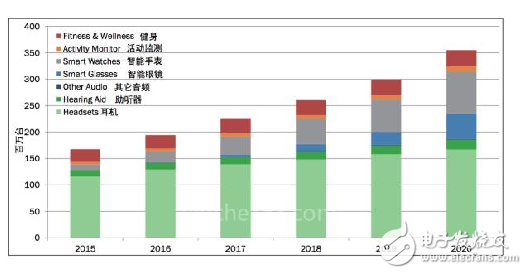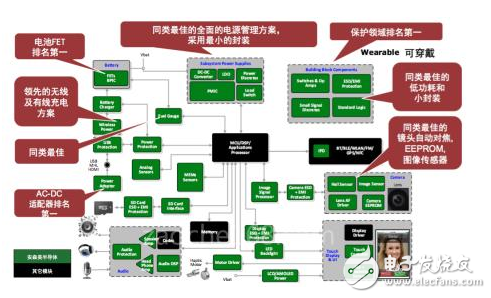With the development of various technologies such as Bluetooth and wireless charging, the wearable market is booming. Wearable devices such as smart watches, smart bracelets and smart glasses have gradually stepped away from the cutting-edge technology and brought more consumers. convenient. Intense market competition requires wearable device manufacturers to design differentiated wearable products in the short term, but there are currently no mature development solutions on the market to meet their needs. ON Semiconductor, which promotes energy-efficient innovation, has introduced the industry's first truly scalable wearable technology design platform to help more manufacturers accelerate their design and development of feature-rich designs that are resounding for consumers and solve current wearable devices. The troubles faced by enterprises.
Wearable electronics prospectsAccording to market analysts IHS and Gartner, the wearable market will continue to show a steady growth trend from 2016 to 2020; in 2016, the shipment of smart wearable products will reach nearly 200 million units, and it is expected to exceed 350 million units by 2020. Among them, smart watches and smart glasses have the fastest growth and huge market potential, and ON Semiconductor's leading hearing aid market will also maintain steady growth, accounting for about 45% of the wearable market revenue.

Figure 1: Wearable market capacity forecast for 2016 to 2020 (data from IHS and Gartner)
ON Semiconductor leads the market with broad capabilitiesThrough long-term investment in innovative technologies and strategic acquisitions, ON Semiconductor has grown into a trial company with annual sales of approximately $5 billion, with comprehensive mobile device power and data management solutions. ON Semiconductor's line of energy-efficient power management, analog, sensor, logic, timing, interworking, discrete, system-on-a-chip (SoC) and custom devices in automotive electronics, communications, industrial, military and aerospace, and consumer And target markets such as computers have a wide range of applications and outstanding performance.
In the wireless and wearable segments, ON Semiconductor continues to focus on the three areas of smartphones/tablets, consumer wearables (non-medical), and smart charging and interoperability, with a broad product lineup and capabilities. In the wearable arena, ON Semiconductor is leading the way in many areas, including power management, battery FETs, wireless and wired charging solutions, fuel gauge solutions, AC-DC adapters, EEPROMs, image sensors and more. Packaging Advantages (Figure 2), these advantages can help create scalable, high-performance, long-life, small form factor, low-power wearable devices.

Figure 2: ON Semiconductor has a broad product lineup and capabilities in the wearable arena, and the green part is its own product.
Based on the needs of the wearable market, ON Semiconductor has introduced the industry's first truly scalable wearable reference design platform, the WDK1.0. The flexible development kit includes hardware, firmware, integrated development environment (IDE) and downloadable SmartApp. Create everything from simple fitness trackers to sophisticated smart watches.
Wearable device manufacturers have different standards for product design, but have consistently high requirements for low power consumption, charging methods, processor performance, size, wireless connectivity, human-machine interface, and sensing capabilities. ON Semiconductor The WDK 1.0 fully satisfies these needs. In order to develop different products, customers only need to replace the processor, MCU, and different screens (or products without screen), and write code, compile, debug, etc. based on the software reference design, so as to accelerate the completion. Wear technical projects to shorten time-to-market and reduce related engineering investments.
The NCP6915 power management IC in the WDK1.0 kit comes with a programmable DCDC and 5 LDOs to accommodate a variety of output voltages while achieving power savings and energy savings. The design engineering team can also make more extensions through the GPIO interface to meet the needs of different products. The kit is also equipped with the NCP1855 battery charger IC, LC709203F fuel gauge IC and a 10W (W) rated SCY1751 wireless charging front controller that supports AirFuel compatible magnetic resonance wireless charging. According to the specific settings, the battery life can reach 24 to 36 hours, and the wired charging is completed within 1 hour, and the wireless charging is completed within 2 hours. As the industry's first wearable solution to support AirFuel's magnetic resonance wireless charging, WDK 1.0 will provide reference and guidance for the future design of wearable devices. In addition, it has a MEMS-based FIS1100 inertial measurement unit that includes a 3-axis gyroscope for multi-dimensional motion tracking and a 3-axis accelerometer. It also comes with an embedded temperature sensor and an LC898301 driver IC for haptic feedback.
In the wind and solar power industries, software used to improve the performance of energy assets has been rapidly adopted and improved. Steve Hanawalt, executive vice president and co-founder of Power Factors, a renewable energy software and service group, believes that although the adoption of digital technology in the field of battery energy storage is slow, investors in large-scale energy storage projects are increasingly aware of management software the power of.
The battery energy storage system is known as an innovative new technology that can solve the intermittent problem of renewable energy power generation and create a series of new sources of income for energy storage operators. But it is still lagging behind in terms of digitization.
In the increasingly mature fields of wind and solar power generation, digital asset management software is becoming a prerequisite for effective portfolio operations, providing energy asset managers and their increasingly savvy investors with a way to monitor performance, manage technology and business risks, Ways to prolong the life of assets and ultimately get returns.
Of course, energy storage systems are a newer asset class than wind power and solar power. In addition, its main interface is a more traditional power grid, and the pace of digital innovation in the power grid is obviously slower than that of renewable energy power generation facilities.
Solar System Batteries,Solar Panel Battery Cost,Enphase Battery Cost,Solar Battery Storage Price
Shenzhen Sunbeam New Energy Co., Ltd , https://www.sunbeambattery.com